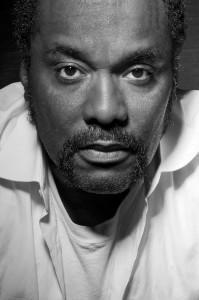
“It’s not easy making champagne out of Kool-Aid, but we did,” said Lee Daniels, director of what is officially known as Lee Daniels’ The Butler. The ambitious period film spans 70 years and tells the story of Cecil Gaines (played by Forest Whitaker), a White House butler under seven presidents, from Dwight Eisenhower to Ronald Reagan, who is a fictionalized version of the real-life Eugene Williams.
Daniels credits his “best of the best” crew for managing to create the film “with a Spielbergian look” at a cost of $30 million, less than half the original $65 million budget proposed to Sony Pictures. The studio backed out of the project because it didn’t feel it could recoup its money, so financing was painstakingly cobbled together from several dozen investors.
“To tell a story that spans seven decades on a shoestring budget should be theoretically impossible,” said Daniels, who shot to fame for helming Precious (2009), a critically-acclaimed film which won two Oscars and was nominated for four more, including two to Daniels for best picture and best achievement in directing. “Everyone on the crew of The Butler was top notch but they weren’t used to working on a film with such a constrained budget, given the demands of the project,” noted Daniels.
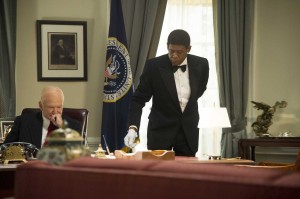
“It was very, very taxing for the crew, even grueling,” he added. “And I was very demanding about the specificity of the look of the White House, the production design, the costumes, and the makeup for the aging of Forest Whitaker and Oprah Winfrey (she plays Gaines’ wife), and the many additional characters such as the other White House butlers. Everyone had to age gradually and convincingly.”
The requirements of the script were enormous. Besides recreating iconic parts of the White House, especially the majestic East Room, through seven presidencies, the production designer was tasked with depicting the history of the civil rights movement in the 1960s, ’70s and ’80s, told through Gaines’ son Louis (Daniel Oyelowo). He is a participant in many of the most significant chapters such as the lunch counter sit-ins, the Freedom Riders, the assassination of Martin Luther King, and the ascendance of the Black Panthers. In addition, the story includes the presidents and their wives, played by famous stars including Robin Williams as President Dwight Eisenhower and Jane Fonda as Nancy Reagan, who are not just dressed convincingly, but through hair, makeup and the use of sophisticated prosthetics, are made to look uncannily like the historic White House occupants.
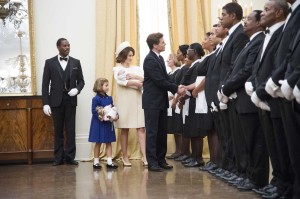 The crew keys included director of photography Andrew Dunn, three-time BAFTA winner, known for lensing The Bodyguard, The History Boys and Gosford Park, as well as Precious, his first teaming with Daniels; editor Joel Klotz, who cut Precious and was nominated for an Oscar; costume designer Ruth Carter, nominated for Oscars for her work on two notable period films about the black experience, Amistad directed by Steven Spielberg and Malcolm X, directed by Spike Lee; and production designer Tim Galvin, who has worked on numerous television shows and films including participation as art director on Quiz Show, Philadelphia and The Silence Of The Lambs.
The crew keys included director of photography Andrew Dunn, three-time BAFTA winner, known for lensing The Bodyguard, The History Boys and Gosford Park, as well as Precious, his first teaming with Daniels; editor Joel Klotz, who cut Precious and was nominated for an Oscar; costume designer Ruth Carter, nominated for Oscars for her work on two notable period films about the black experience, Amistad directed by Steven Spielberg and Malcolm X, directed by Spike Lee; and production designer Tim Galvin, who has worked on numerous television shows and films including participation as art director on Quiz Show, Philadelphia and The Silence Of The Lambs.
“The crew, both black and white, did it with such gusto and with such passion,” said Daniels. “Money be damned. It was really about telling this unique story, and because this tale hadn’t been told before, it was a priority for each of them to hit it out of the park.”
The film was shot in Louisiana, taking advantage of the state’s bountiful tax credits. The biggest challenge was finding settings that could stand in for the White House, especially the familiar red-carpeted hallway to the East Room. Luckily, a public building in New Orleans – the old U.S. Customs House – had the requisite columns and was turned into a spitting image, after lots of dressing and masking and decorating. The nearly one dozen settings for different events in the Civil Rights movement were difficult to get right, because they were so numerous.
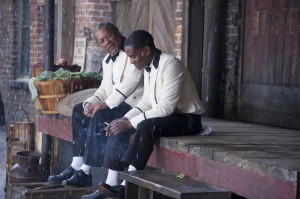 The art department, given the many demands, was hit the hardest by the reduced budget, according to the director. “Tim deserves a medal of honor for his team,” said Daniels. He singled out for praise set decorator Diane Lederman, who obtained truckloads of items from New York and other cities, in order to make the ever-changing White House interiors seem authentic, and also to create a rich interior for the Gaines household. “It was almost like going to war, the detail they put together,” Daniels observed. “They worked for very little money, tirelessly and effortlessly.”
The art department, given the many demands, was hit the hardest by the reduced budget, according to the director. “Tim deserves a medal of honor for his team,” said Daniels. He singled out for praise set decorator Diane Lederman, who obtained truckloads of items from New York and other cities, in order to make the ever-changing White House interiors seem authentic, and also to create a rich interior for the Gaines household. “It was almost like going to war, the detail they put together,” Daniels observed. “They worked for very little money, tirelessly and effortlessly.”
DP Dunn delivered a rich canvas with his cinematography, with saturated colors and an epic sweep, at the same time paying attention to the story- and actor-driven dynamic of the film so that characters are never slighted but prominently pop out. This followed Daniels’ discussion in prep with the DP. “As with most of my actors, I have a short-hand with Andrew,” noted the director. “In one of these I told him, ‘I want it to look like Steven Spielberg did this movie. This is not Monster’s Ball and not Precious. In the end we gave it a rich non-indie look.” To streamline the film and keep within the budget, some of the presidencies, like that of Jimmy Carter, were handled briefly using stock documentary footage.
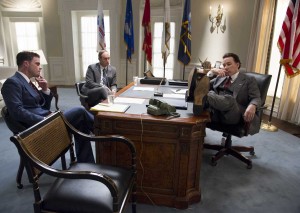 “You must always call her the fabulous Ruth Carter,” the director said about his costume designer. After extensive research, Carter came up with a lot of looks that communicated the different periods through changes in clothing, from the double-breasted suit of Eisenhower to the square-shouldered Dynasty look for Nancy Reagan. In all Carter had to come up with 250 costumes for nearly 100 characters, including civil rights leaders, politicos, the presidents and their spouses, and members and friends of the Gaines family. She referenced different couturiers favored by both Mrs. Reagan and Jacqueline Kennedy. And she studiously recreated the blood-stained pink dress that Mrs. Kennedy wore when she returned from Dallas. For the black characters in the movie, including Winfrey, she went back to old copies of Ebony magazine for inspiration.
“You must always call her the fabulous Ruth Carter,” the director said about his costume designer. After extensive research, Carter came up with a lot of looks that communicated the different periods through changes in clothing, from the double-breasted suit of Eisenhower to the square-shouldered Dynasty look for Nancy Reagan. In all Carter had to come up with 250 costumes for nearly 100 characters, including civil rights leaders, politicos, the presidents and their spouses, and members and friends of the Gaines family. She referenced different couturiers favored by both Mrs. Reagan and Jacqueline Kennedy. And she studiously recreated the blood-stained pink dress that Mrs. Kennedy wore when she returned from Dallas. For the black characters in the movie, including Winfrey, she went back to old copies of Ebony magazine for inspiration.
In addition to the contributions of makeup designer Diana Denson and hair department head Candace Neal and their teams, renowned prosthetic artist Matthew Mungle did the subtle aging changes for the main characters.
Music supervisor Lynn Fainchtein introduced Daniels to Portuguese composer Rodrigo Leão who did the score. Fainchtein also picked the popular songs by artists like James Brown and Little Shorty Long that helped anchor the changing times to sounds of the different eras. “She’s my Mexican secret,” said the director of Fainchtein, who is based south of the border and has worked on all of Daniels’ soundtracks and with a number of Mexican directors, most notably Alejandro González Iñárritu.
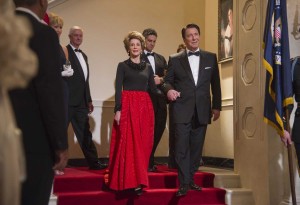 The editing process turned out to be one of the most difficult parts of making The Butler, primarily due to a very accelerated schedule for locking the film at the request of Harvey Weinstein (The Weinstein Company released the movie.) “The film was supposed to come out in October but Harvey decided it could make more money if it hit theaters in August,” Daniels explained. “It was terrifying. It was like inducing labor, but the main priority was at all times to protect the child.” With Klotz already at work cutting the film, Daniels brought in a second editor, Brian Kates, to meet the expedited deadline. Despite the need to crash edit the film, Weinstein turned out to be prescient. The Butler was released in mid-August, and was the first film of 2013 to top the box office for three straight weeks. The film has taken in nearly $170 million at the box office both domestically and worldwide, making it solidly profitable given its more modest final budget. “The crew was especially happy at the financial success of the film,” said Daniels.
The editing process turned out to be one of the most difficult parts of making The Butler, primarily due to a very accelerated schedule for locking the film at the request of Harvey Weinstein (The Weinstein Company released the movie.) “The film was supposed to come out in October but Harvey decided it could make more money if it hit theaters in August,” Daniels explained. “It was terrifying. It was like inducing labor, but the main priority was at all times to protect the child.” With Klotz already at work cutting the film, Daniels brought in a second editor, Brian Kates, to meet the expedited deadline. Despite the need to crash edit the film, Weinstein turned out to be prescient. The Butler was released in mid-August, and was the first film of 2013 to top the box office for three straight weeks. The film has taken in nearly $170 million at the box office both domestically and worldwide, making it solidly profitable given its more modest final budget. “The crew was especially happy at the financial success of the film,” said Daniels.
The Butler is one of a handful of films that came out in 2013, all together making up a kaleidoscope of the black experience in America. These include 12 Years a Slave, Fruitvale Station, Mandela—Long Walk to Freedom and 42. “It’s a wonderful time for so many African-American artists. We’ve been shut out for far too long,” said Daniels. “But it’s a very exciting time not just for African-Americans in Hollywood, but for Hollywood itself. I just hope we’ll be allowed to keep making such pictures.”





